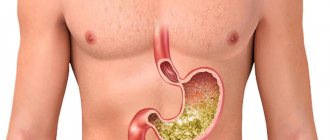Back to list Previous article Next article
11.10.2017
Tags:
baby, constipation, causes, prevention
5/5 — (2 votes)
Normally, a newborn's bowels, especially those from birth to six weeks, should have bowel movements several times a day. This usually happens after every feeding. Sometimes it happens that a baby may not have bowel movements for a week. If your baby doesn't show any concern, you shouldn't worry either. In such cases, the reason for the absence of bowel movements is the almost complete absorption of breast milk. That is, a small amount of waste enters the intestines, and it will be emptied only when they accumulate in sufficient quantities. But if the lack of stool in an infant is accompanied by bloating and increased gas formation, he shows anxiety, cries and strains , then mothers need to take urgent measures - this is constipation !
Diseases and risk factors
Constipation in children can be caused by a number of diseases that directly or indirectly affect the digestive process.
Hirschsprung's disease
This disease is characterized by a congenital defect in the nerve endings of the colon. These nerve endings are necessary to regulate the contractile function of the intestines, due to which feces are transported. Due to the lack of nerve endings, the intestinal walls do not contract, thereby causing stagnation and accumulation of contents.
Celiac disease
Celiac disease, or celiac disease, is a chronic digestive and immune disorder that damages the small intestine. The disease occurs due to eating foods containing gluten. Gluten is a protein found primarily in flour products such as pasta, cookies, and bread.
This disease occurs due to genetic characteristics of a person, which lead to the inability of the intestines to absorb gluten and disrupt the process of formation of feces.
Spina bifida
A congenital spinal malformation, a type of neural tube defect, often combined with defects in the development of the spinal cord. The defect is an incomplete closure of the neural tube in an incompletely formed spinal cord, which leads to paralysis of the lower extremities, bowel and bladder dysfunction.
Hypothyroidism
Hypothyroidism or underactive thyroid gland. The thyroid gland is an organ that produces a large number of hormones that control the functioning of the body. If the gland does not produce enough hormones, a person experiences a number of symptoms, which include constipation.
Constipation can also be caused by other diseases that affect the digestion process in one way or another. These include various tumors pressing on the intestines, injuries to the brain and spinal cord, and diabetes.
A number of medications can also cause indigestion:
- Anticonvulsants;
- Preparations containing aluminum and calcium - antacids;
- A number of painkillers;
- Some antidepressants;
- Antispasmodics.
Prevention Tips
Parents of a small child need to know about measures to prevent constipation. These include:
- maintaining breastfeeding for at least six months;
- careful selection of formula if breastfeeding is not possible;
- introduce the first complementary foods no earlier than 5 months;
- the volume of the mixture and feeding regimen should be strictly observed according to the child’s age;
- additionally give boiled water, raisin decoction, dried fruits to drink;
- if there is a tendency to retain stool, do not feed the baby semolina and rice porridge, introduce prune puree;
- Do exercises and outdoor games with your baby;
- before feeding, do not forget to keep the baby in the tummy position;
- in hot weather, give more fluids, do not overheat due to too warm clothes;
- If you need to take antibiotics, ask your doctor about probiotics;
- A nursing mother needs to monitor the intake of medications that affect intestinal tone; vitamins with iron, sedatives, and antispasmodics can lead to constipation.
It is better to prevent the problem of constipation in children than to treat it. Parents are required to pay attention and understanding of the baby's condition. A nursing mother is the child’s main protection, so she needs to be protected and conditions created to prolong lactation.
Signs of the disease
Source: t.tomsickova / Depositphotos
Clinical manifestations of constipation are varied. They become most pronounced with prolonged constipation and are:
- Bowel movements less than 2 times a week;
- The stool comes out heavily, its substance is dry, hard, consisting of many pieces;
- Defecation is accompanied by pain;
- The child may feel that some of the contents have not come out;
- Abdominal pain and bloating;
- Traces of liquid stool on underwear.
You should immediately seek medical help if you have the following symptoms:
- Bleeding from the anus;
- Blood in the stool;
- Weight loss;
- Vomit.
If older children can talk about a problem with the intestines, then parents may not even be aware of the problem of a very young child.
Important: symptoms of constipation in an infant:
- Problems with sleep, the child often wakes up and cries.
- When changing the diaper and washing the baby, he behaves restlessly, fidgets, and begins to cry. This is associated with pain during bowel movements.
- The baby poops less frequently than usual and his or her stools are hard or pellet-like.
Chronic constipation is characterized by skin changes. It becomes pale, acquires an earthy tint, and loses elasticity. Becomes dry and flaky. There is a coated tongue and bad breath.
How to find out the reason?
Symptomatic measures that induce defecation become addictive over time and lose their properties. Therefore, one cannot hope that the child will grow up and everything will return to normal “by itself.” It is important that it is in the infant period that the conditions for pathology in adulthood are formed. Therefore, if there are repeated problems with stool retention, it is necessary to conduct an examination and find out the cause.
Ultrasound of the abdominal cavity can reveal congenital pathology. In mild cases, it is treated with conservative methods. If there are significant changes, you should agree to surgery. Consultation with a neurologist helps to find out the cause of intestinal atony. A pediatric gastroenterologist will monitor the baby’s diet, identify lactulose deficiency and provide nutritional recommendations.
Your child may need to be tested for food allergies.
Mother's diet
Source: Alexander Dummer: Pexels
Breastfeeding mothers often wonder how their diet affects the quality of their breast milk and how choosing foods for it can affect the baby's digestive system. However, most women do not need to restrict their diet while breastfeeding and should aim for a nutritious and varied diet.
In some cases, infants may seem to avoid feeding after the mother has taken certain foods. In this case, a woman can simply eliminate this food from her diet and return to it after stopping breastfeeding.
Important: Special recommendations include avoiding caffeine while breastfeeding. Caffeine is easily transmitted to the baby through milk. It reduces the amount of iron in milk, which can lead to iron deficiency anemia. It is recommended that a nursing mother consume no more than 400 milligrams of caffeine per day. The most caffeine is found in coffee and chocolate, and the least in tea.
A healthy diet while breastfeeding is essentially the same as a nutritious diet without breastfeeding. The main difference is that breastfeeding people need 450 to 500 extra calories per day. But if you want to lose weight after pregnancy, you can do without them, having first discussed this with your doctor.
A healthy diet for a pregnant woman includes:
- Fruits, especially rich in potassium and vitamin A (melon, banana, apricot, mango, oranges). Helps reduce the risk of constipation in both the child and the mother;
- Vegetables containing vitamin A and potassium (spinach, carrots, tomatoes, red peppers);
- Grain products, especially brown rice and whole grain bread;
- Protein-containing foods such as beans, peas, nuts, meat, fish, mussels.
Important: A nursing mother needs to drink a lot of water, especially in the first weeks after birth. Lack of fluid negatively affects milk production. A sufficient amount of water ensures the efficient functioning of the digestive system, helps food to be absorbed, which means breast milk will be well-balanced in nutrients. The higher the conditional quality of milk, the lower the likelihood of constipation in a child, since balanced milk improves peristalsis and fecal removal.
Temporary stool disorders
Difficulty in defecation may be temporary. Many babies experience difficulty with bowel movements - they strain, grunt, and whine during bowel movements, although their stool remains soft and mushy. This condition is quite normal for children in the first two months of life; it is associated with the immaturity of the nervous system and is called “dyschezia”4.
Temporary disruption of bowel movements in a child may be due to the following factors:
- lack of fluid - in some cases the child needs to be supplemented with food, although some mothers believe that when breastfeeding, the baby receives a sufficient amount of fluid in the form of milk2.5;
- general dehydration of the baby against the background of high fever, vomiting and diarrhea, for example, with an intestinal infection or ARVI, when a large amount of water is lost through sweat, vomit and liquid feces 4;
- malnutrition of a nursing mother: a small amount of fluid, following an unbalanced diet, low fiber content and a large number of “fixing” foods in the diet2;
- underfeeding of the child due to a deficiency of breast milk (in this case, the woman may not even suspect that she has little milk) and the mother’s “tight” breasts, general weakness and persistent regurgitation in the baby2,5;
- too early and irrational introduction of complementary feeding2;
- abuse of enemas and means of mechanical stimulation of defecation in a child (gas tube, irritation of the anus, etc.)2;
- psychological factors2, which include the mother’s psycho-emotional problems, the absence of a mother and getting used to a nanny, moving, frequent contacts with new people;
- any diseases and teething - they affect not only the well-being, but also the emotional and psychological state of the child, and at the same time - on intestinal motility.
Elimination of all of the above factors leads to spontaneous normalization of the child’s stool.
Up to contents
Age norms
A breastfed newborn baby can have bowel movements as many times as he is fed. If a child has stool 1-2 times a day or less during the first 3 months of life, you should consult a doctor. For bottle-fed children under one year of age, constipation is considered to be the absence of independent bowel movements during the day.
A common cause of constipation in breastfed infants is disturbances in feeding and nutrient absorption.
If there is quantitative underfeeding or good absorption of the mother's breast milk, the volume of feces in the child is not sufficient to arouse the urge to defecate. In such cases, retention of stool for 2-3 days is not considered true constipation.
Important: Constipation in infants who are breastfed and complementary foods is caused by a lack of foods containing plant fiber. Excess fat in food aggravates constipation and promotes even greater hardening of stool.
In addition to reducing the frequency of bowel movements with constipation, children may experience a decrease in appetite and abdominal pain. With chronic constipation, the volume of stool increases.
What not to do
First of all, don't wait for the problem to go away on its own. Repeated and prolonged bowel movements in infants always require consultation with a pediatrician.
In addition, it is not recommended:
- feed the baby strictly according to the clock - the baby himself “knows” how much milk he needs and when; feeding on demand promotes normal bowel function and, in addition, stimulates lactation in the mother;
- supplementing breastfeeding after regurgitation: this is a normal act that helps the baby get rid of air and excess food trapped in the stomach;
- supplement the baby with formula or completely switch to artificial feeding, believing that the baby does not have enough milk - the guideline for the fact that he has enough food should be good sleep and normal weight gain;
- frequently use a gas tube, resort to enemas and other methods of stimulating bowel movements;
- use traditional methods of stimulating the rectum, for example, inserting a piece of soap into the anus: soap irritates the mucous membrane and can cause a chemical burn; the laxative effect can be achieved using gentle means, for example, MICROLAX® microenemas;
- take medications without consulting a doctor - all of them can enter the child’s body along with milk and affect his body in general and the functioning of the gastrointestinal tract in particular.
Up to contents
Causes and types
Source: freepik - ru.freepik.com
Constipation in a child can be one of the manifestations of diseases not directly related to the pathology of the gastrointestinal tract (such as rickets, hypothyroidism). However, in the vast majority of cases, constipation is caused by problems with the intestines themselves.
During digestion, the intestinal walls contract in waves, pushing the contents towards the outlet - this phenomenon is called peristalsis or intestinal motility. There are two main options for intestinal motility disorders:
If the child’s stool is very rare, accompanied by bloating, and the volume of feces during bowel movements is large (as in an adult), we can assume that this is the so-called atonic constipation. Constipation associated with insufficient contractile activity of the intestines is called atonic. In this case, the child may not have the urge to defecate for a long time.
Compulsory measures (long-term potty training) usually only aggravate the situation and reinforce the child’s negative attitude towards what is happening.
Thick stools consisting of hard, smooth pellets (the so-called “sheep feces”), abdominal pain, and sometimes pain during defecation usually indicate spastic constipation. Spastic constipation in children occurs due to spasms (increased contractile activity) of the intestines.
In some cases, stool is released in the form of a ribbon or a thin stream. In such a situation, the child should be consulted with a surgeon to exclude organic pathology of the rectum (narrowing, neoplasm).
Why does a small child have a problem?
To properly treat constipation, it is necessary to distinguish physiological causes related to nutrition from early intestinal pathology (possibly congenital anomalies). Therefore, parents should rely less on the advice of grandmothers and call a doctor. The child needs urgent help, and the parents need recommendations on how to get rid of constipation in the future. Let's look at the most common reasons.
Intestinal pathology
Among the causes of constipation in an infant, organic pathology must be distinguished. It is usually diagnosed in a maternity facility in the first days of a baby’s life during an examination by a pediatric neonatologist. Birth defects include:
- dolichosigma - an enlarged sigmoid colon with a high probability of torsion and intestinal obstruction, the baby quickly develops fecal intoxication;
- Hirschsprung's disease - denervation of part of the intestine (absence of nerve endings in the walls).
As a result, the contents cannot overcome mechanical obstacles, the intestines “refuse” to move feces, and become overstretched
Anomalies are quite rare. In 2/3 of cases, they are diagnosed in children under one year of age. With sufficient compensation, constipation may not be noticed in a newborn; then it becomes habitual and is detected at 6–7 years of age and even in adulthood. More often found in children with genetic diseases. For example, with Down syndrome.
Such cases require urgent diagnosis and surgical treatment. It is impossible to combat the pathology with other methods, and delaying surgical intervention will only lead to serious complications in the form of inflammation, obstruction and peritonitis.
Features of nutrition of a nursing mother
There are two points of view about the effect of mother's milk on constipation in a newborn. Some experts argue that substances harmful to the baby cannot penetrate into breast milk, since it is synthesized from lymph and blood. This means that the importance of a nursing mother’s diet in the occurrence of defecation disorders in a child is exaggerated.
Others insist on changing the composition of milk when the mother’s diet is different. Therefore, in order to make the baby’s intestines easier, the mother should exclude from her diet foods that delay intestinal motility (fresh baked goods, rice porridge, fatty meat, bananas, whole milk, nuts, seeds, spicy cheese).
Lactase deficiency
Some children are born with a congenital deficiency of the lactase enzyme, which breaks down this substance in milk, and they also have an allergic reaction to cow's milk protein. As a result of intolerance, stool retention occurs.
Attentive mothers themselves determine which product their baby reacts to.
Lack of fluid
This reason occurs in cases of artificial feeding. A sufficient amount of water in the diet allows you to dilute the stool. Otherwise, they become thick and the intestines require additional efforts to move feces.
Constipation in an infant occurs due to the introduction of complementary foods. As long as nutrition comes only from breast milk, the baby receives enough fluid. But solid food requires adding and expanding the drinking regime. More water is needed at elevated temperatures, on a hot day, if the child is sweating in warm clothes.
Early introduction of complementary foods
For each baby, complementary foods are introduced at their own time. Parents should not try to speed up the transition to artificial feeding and abandonment of breast milk. At the age of three months, the child’s gastrointestinal tract is still poorly adapted to mixtures, juices, and “purees.” When artificially feeding, complementary foods are recommended to be introduced no earlier than 4 months, and when breastfeeding - at six months.
The child's digestive system does not yet produce enough enzymes. You can help your baby during the transition to artificial formula by gradually replacing one of the breastfeedings, then more. It is not recommended to give up breastfeeding during the period after your baby has suffered an infectious disease, a cold, or a severe reaction to teething.
Quality of complementary foods
The problem of constipation may indicate an incorrectly selected mixture, sudden replacement, or age inappropriateness. Advertising does not always correspond to the real properties of artificial nutrition. You need to consult with an experienced specialist.
With the timely introduction of complementary foods, it is necessary to provide for the presence of dietary fiber in the composition. They are provided by fruits and vegetables. The child needs to be accustomed to them; he eats semolina and rice porridge with much greater desire. Adding plant fiber will require additional drinking. In the presence of sufficient water, the fibers swell and pass out of the intestines naturally.
Constipation in response to antibiotic treatment
Antibacterial drugs have the negative property of destroying beneficial intestinal bacteria. This process occurs especially quickly in children under one year of age. Doctors prescribe antibiotics only when absolutely necessary for a short course. But there are serious illnesses in which one should think about preserving the life of a small patient.
Different means are used, some are replaced by others that are more sensitive. Subsequent dysbiosis manifests itself as constipation and diarrhea. Parents should not give any antibacterial drugs to their child themselves.
Constipation due to stress
While learning about the world around him, the baby encounters frightening phenomena. He experiences them in his own way. The transition to kindergarten, a new environment, punishment - these are stressful situations for a child. We must not forget about them. The body is able to react by holding stool even when trying to potty train.
Separation from mother is the most severe stress
Alimentary constipation
Also called "hungry". Due to underfeeding, a sufficient volume of feces is not formed in the intestines. Perhaps the lack of breast milk was not immediately noticed. In asocial families, the situation is complicated by the lack of funds to purchase nutritional mixtures. The child suffers and screams from colic in the stomach and hunger. He gains weight poorly and does not develop according to his age.
Treatment of constipation in children
Should I get an enema for constipation? It is not worth resorting to enemas often, since this suppresses the natural urge to defecate and disrupts the normal formation of the reflex. However, occasionally for constipation in children, you can use this remedy, following all the necessary recommendations. You can learn how to properly give an enema to a child from this video:
The volume of an enema for constipation in a newborn child up to 1 month is 30 ml, for a child 1-3 months - 30-40 ml (the smallest enema, not completely filled), for a child 3-6 months - 90 ml, 6-12 months - 120-180 ml. It is important to remember that the water in the enema should not be warm, but at room temperature (22-24 degrees). Toxic substances accumulated in the intestines quickly dissolve in warm water and are subsequently easily absorbed into the bloodstream.
If it seems that the intestines have not been completely cleansed, you should not rush: usually after the first portion, provoked by an enema, there is independent stool. Large-volume enemas should be performed by a doctor, as serious complications can occur.
What to do if your child is constipated?
- For any constipation in children, it is important that the child receives enough fluid - with water or clear, low-fat broth.
- For atonic constipation, massage of the anterior abdominal wall in a clockwise direction, laying on the stomach, and mild tactile irritation of the anus helps well.
- For spastic constipation, it is possible to use baby suppositories with glycerin. You should not introduce any foreign substances (soap, baby oil, etc.) into the rectum.
Treatment of constipation (especially chronic) in children is impossible without adherence to the regimen. It is advisable to teach your child to go and poop at the same time every day. To stimulate bowel movements, you can give your child a drink of cold water or fruit (for example, apple) juice in an age-appropriate dose. These activities must be carried out at the same time every day.
Constipation after introducing complementary foods
The baby is growing, improving his skills, and it’s time to introduce him to new foods. These circumstances, on the one hand, help to establish peristalsis, and on the other, increase the risk of constipation.
By six months, the baby is already trying to control bowel movements, because he has realized that unpleasant sensations appear after it - itching, burning and other discomfort in the areas where feces fall. In order not to experience discomfort, the child tries to restrain the urge. At first he fails to do this, because the rectum has already learned to work - to reflexively contract and push out waste. And after a couple of months everything works out, the baby wins and starts on the path leading to chronic constipation. To take the child beyond this vicious circle, the mother must minimize the duration of contact of the baby’s skin with feces and expand his diet by introducing complementary foods.
Proteins, fats and carbohydrates included in foods are absorbed in the small intestine, but do not reach the large intestine, where feces are formed. The same cannot be said about fiber. While the baby drinks breast milk or formula, this component of the dish is unfamiliar to him. Even if a nursing woman herself eats a lot of plant foods, the baby gets nothing. Fiber, as already noted, is not absorbed in the intestines, does not enter the blood, which means it is not in breast milk. For the first time, the baby receives fiber with complementary foods, trying his first 25 grams of pureed zucchini, carrots and other vegetables. Plant fibers literally attract all waste, resulting in the formation of feces, which help the intestines master proper peristalsis. In this section of the gastrointestinal tract, in the intestines, there are many muscles, they must learn to consistently contract - tense and relax - in order to squeeze waste out.
The next new product should be introduced a month after the previous one. The new product will likely cause more frequent and loose stools at first. If it is not green and does not foam, there is no need to run to the doctor and ask to prescribe fixatives. Be patient, after a while the innovation will be mastered and bear fruit. Instead of liquid and shapeless yellow-white feces, you will see formed brown feces.
Traditional methods of treatment
In addition to standard treatments, there are alternative ways to combat constipation.
Abdominal massage
In addition to relieving symptoms and treating constipation, abdominal massage has a strengthening effect on the abdominal muscles and relieves pain from infant colic.
Source: oksun70 / Depositphotos
The essence of the massage is light and gentle stroking of the child’s abdomen, smoothly transitioning to pinpoint pressure with the pad of the index finger from the navel to the periphery. The massage also ends with a smooth transition to stroking. The procedure is performed an hour before and after meals.
Treatment with medicinal plants
Many plants have a laxative effect and can be used as an auxiliary element in complex treatment. These plants include:
- anise;
- zhoster laxative;
- dandelion officinalis;
- horse sorrel;
- big plantain.
Plants are taken in the form of decoctions, infusions and teas. It is recommended to take breaks between courses of treatment for 2-3 weeks. This is necessary to avoid getting used to the fees and reducing their effectiveness.
It is not recommended to use medicinal laxatives without a doctor’s prescription: they can lead to increased gas formation and cause discomfort in the child.
Acupuncture
Acupuncture is an element of traditional Chinese medicine. The essence of the method is to insert thin needles into different parts of the body. To treat constipation, needles are inserted into the area of the large intestine. This procedure helps to relax the intestinal walls and facilitate bowel movements.
Insufficient knowledge of the effectiveness of acupuncture prevents it from becoming a standard method in the treatment of constipation. The method may be accompanied by pain and bleeding.
Important: Acupuncture should only be performed by a qualified professional. And it is worth remembering that any trend from alternative medicine cannot replace real, evidence-based treatment.









